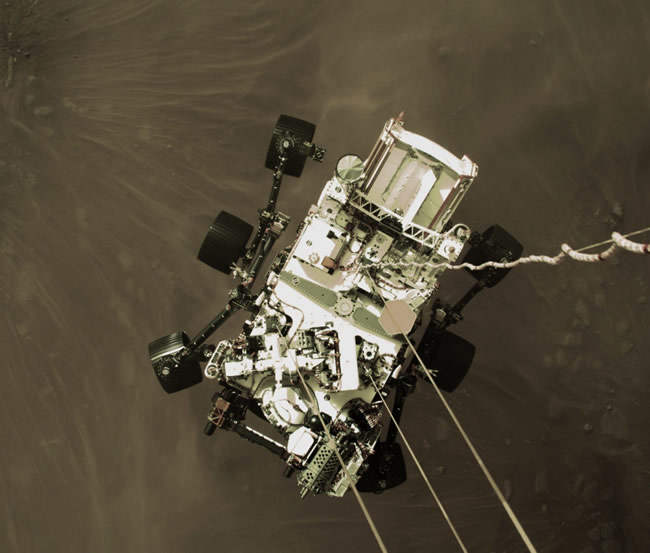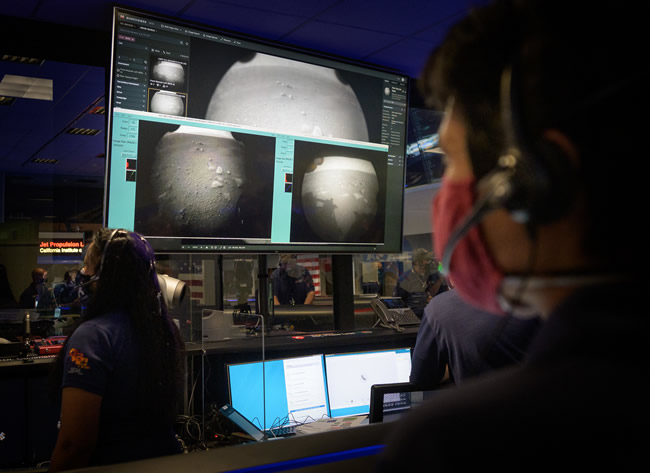« TIME Reveals the 2021 List of the Next 100 Most Influential People in the World | Main | TAG Heuer Brand Ambassador Naomi Osaka wins the first Grand Slam of 2021 »
February 19, 2021
Touchdown! NASA's Mars Perseverance Rover Safely Lands on the Red Planet

Photo: This high-resolution still image is part of a video taken by several cameras as NASA’s Perseverance rover touched down on Mars on Feb. 18, 2021. A camera aboard the descent stage captured this shot. A key objective for Perseverance’s mission on Mars is astrobiology, including the search for signs of ancient microbial life. The rover will characterize the planet’s geology and past climate, paving the way for human exploration of the Red Planet and be the first mission to collect and cache Martian rock and regolith (broken gravel and dust). (Credit: NASA/JPL-Caltech).

Photo: The Empire State Building is illuminated in red to celebrate this Thursday’s scheduled landing on Mars of NASA’s Perseverance rover, Tuesday, Feb. 16, 2021, in New York City. A key objective for Perseverance’s mission on Mars is astrobiology, including the search for signs of ancient microbial life. The rover will characterize the planet’s geology and past climate, paving the way for human exploration of the Red Planet and be the first mission to collect and cache Martian rock and regolith. Photo Credit: (NASA/Emma Howells).

Photo: NASA Mars Perseverance Live at One Times Square. The live NASA TV broadcast from inside the Mission Support Area of NASA’s Jet Propulsion Laboratory is seen on the One Times Square video board as NASA’s Perseverance rover completes its descent towards the surface of Mars, Thursday, Feb. 18, 2021, in New York City. A key objective for Perseverance’s mission on Mars is astrobiology, including the search for signs of ancient microbial life. The rover will characterize the planet’s geology and past climate, paving the way for human exploration of the Red Planet and be the first mission to collect and cache Martian rock and regolith. Photo Credit: (NASA/Emma Howells).

Photo: Members of NASA’s Perseverance Mars rover team watch in mission control as the first images arrive moments after the spacecraft successfully touched down on Mars, Thursday, Feb. 18, 2021, at NASA’s Jet Propulsion Laboratory in Pasadena, California. A key objective for Perseverance’s mission on Mars is astrobiology, including the search for signs of ancient microbial life. The rover will characterize the planet’s geology and past climate, paving the way for human exploration of the Red Planet and be the first mission to collect and cache Martian rock and regolith. Photo Credit: (NASA/Bill Ingalls).
WASHINGTON, Feb. 18, 2021 — The largest, most advanced rover NASA has sent to another world touched down on Mars Thursday, after a 203-day journey traversing 293 million miles (472 million kilometers). Confirmation of the successful touchdown was announced in mission control at NASA’s Jet Propulsion Laboratory in Southern California at 3:55 p.m. EST (12:55 p.m. PST).
The Mars 2020 mission launched July 30, 2020, from Cape Canaveral Space Force Station in Florida. The Perseverance rover mission marks an ambitious first step to collect Mars samples and return them to Earth.
“This landing is one of those pivotal moments for NASA, the United States, and space exploration globally - when we know we are on the cusp of discovery and sharpening our pencils, so to speak, to rewrite the textbooks,” said acting NASA Administrator Steve Jurczyk. “The Mars 2020 Perseverance mission embodies our nation’s spirit of persevering even in the most challenging of situations, inspiring and advancing science and exploration. The mission itself personifies the human ideal of persevering toward the future and will help us prepare for human exploration of the Red Planet in the 2030s.”
About the size of a car, the 2,263-pound (1,026-kilogram) robotic geologist and astrobiologist will undergo several weeks of testing before it begins its two-year science investigation of Mars’ Jezero Crater. While the rover will investigate Jezero’s ancient lakebed and river delta’s rock and sediment to characterize the region’s geology and past climate, a fundamental part of its mission is astrobiology, including the search for signs of ancient microbial life.
“Because of today’s exciting events, the first pristine samples from carefully documented locations on another planet are another step closer to being returned to Earth,” said Thomas Zurbuchen, associate administrator for science at NASA. “Perseverance is the first step in bringing back rock and regolith from Mars. We don’t know what these pristine samples from Mars will tell us. But what they could tell us is monumental - including that life might have once existed beyond Earth.”
Some 28 miles (45 kilometers) wide, Jezero Crater sits on the western edge of Isidis Planitia, a giant impact basin just north of the Martian equator. Scientists have determined that 3.5 billion years ago, the crater had its river delta filled with water.
The power system that provides electricity and heat for Perseverance through its exploration of Jezero Crater is a Multi-Mission Radioisotope Thermoelectric Generator or MMRTG. The U.S. Department of Energy (DOE) provided it to NASA through an ongoing partnership to develop power systems for civil space applications.
“Perseverance is the most sophisticated robotic geologist ever made, but verifying that microscopic life once existed carries an enormous burden of proof,” said Lori Glaze, director of NASA’s Planetary Science Division. “While we’ll learn a lot with the great instruments we have aboard the rover, it may very well require the far more capable laboratories and instruments back here on Earth to tell us whether our samples carry evidence that Mars once harbored life.”
• Paving the Way for Human Missions
“Landing on Mars is always a challenging task, and we are proud to continue building on our past success,” said JPL Director Michael Watkins. “But, while Perseverance advances that success, this rover is also blazing its path and daring new challenges in the surface mission. We built the rover to land and find and collect the best scientific samples for return to Earth. Its incredibly complex sampling system and autonomy not only enable that mission, but they also set the stage for future robotic and crewed missions.”
The Mars Entry, Descent, and Landing Instrumentation 2 (MEDLI2) sensor suite collected data about Mars’ atmosphere during entry, and the Terrain-Relative Navigation system autonomously guided the spacecraft during the final descent. The data from both would help future human missions land on other worlds more safely and with larger payloads.
On the surface of Mars, Perseverance’s science instruments will have an opportunity to shine scientifically. Mastcam-Z is a pair of zoomable science cameras on Perseverance’s remote sensing mast, or head, that creates high-resolution, color 3D panoramas of the Martian landscape. Also located on the mast, the SuperCam uses a pulsed laser to study the chemistry of rocks and sediment and has its microphone to help scientists better understand the stones’ properties, including their hardness.
The rover chassis is home to three science instruments, as well. The Radar Imager for Mars’ Subsurface Experiment (RIMFAX) is the first ground-penetrating Radar on the surface of Mars.
Currently attached to Perseverance’s belly, the diminutive Ingenuity Mars Helicopter is a technology demonstration that will attempt the first powered, controlled flight on another planet.
Project engineers and scientists will now put Perseverance through its paces, testing every instrument, subsystem, and subroutine over the next month or two. Only then will they deploy the helicopter to the surface for the flight test phase. If successful, Ingenuity could add an aerial dimension to exploring the Red Planet in which such helicopters serve as scouts or make deliveries for future astronauts away from their base.
Once Ingenuity’s test flights are complete, the rover’s search for evidence of ancient microbial life will begin in earnest.
“Perseverance is more than a rover, and more than this amazing collection of men and women that built it and got us here,” said John McNamee, project manager of the Mars 2020 Perseverance rover mission at JPL. “It is even more than the 10.9 million people who signed up to be part of our mission. This mission is about what humans can achieve when they persevere. We made it this far. Now, watch us go.”
• More About the Mission
A primary objective for Perseverance’s mission on Mars is astrobiology research, including searching for signs of ancient microbial life. The rover will characterize the planet’s geology and past climate and be the first mission to collect and cache Martian rock and regolith, paving the way for human exploration of the Red Planet.
JPL, a Caltech (California Institute of Technology) division in Pasadena, California, manages the Mars 2020 Perseverance mission and the Ingenuity Mars Helicopter technology demonstration for NASA.
Source: NASA
|GlobalGiants.Com|
Miss my landing? Catch the highlights below.
— NASA's Perseverance Mars Rover (@NASAPersevere) February 19, 2021
Send us your own highlights too. Share your pictures and video using #CountdownToMars. pic.twitter.com/OL2wSAi36e







Edited & Posted by the Editor | 3:29 AM | Link to this Post







